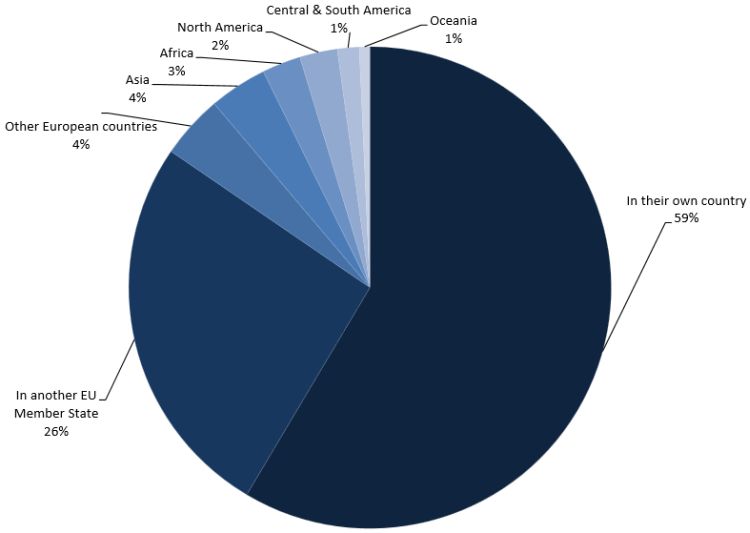Analytics, Baltic States – CIS, EU – Baltic States, Tourism
International Internet Magazine. Baltic States news & analytics
Thursday, 25.04.2024, 03:55
Potentials for European tourism: non-EU residents
 Print version
Print version
On the occasion of the World Tourism Day, celebrated each year at the end of September, Eurostat, the statistical office of the European Union, publishes a selection of data on tourism between the EU and the rest of the world.
When travelling, EU residents spent almost 85% of their tourism nights within the EU, with only just over 15% in extra-EU destinations.
At the EU-28 level, tourism patterns, both for incoming and outgoing tourists, are clearly shaped by geographical, historical, cultural and linguistic factors.
 |
| Nights spent by EU tourists worldwide, by continent, 2014 |
Infographics on tourism is available on the Eurostat website at:
Non-EU tourists
More than 300 million nights were spent in the EU by non-EU visitors in tourist accommodation in 2014. With 17.8% and 14.9% respectively of all nights spent by non-EU tourists in the EU in 2014, tourists from the United States and Russia were the main visitors from outside the EU, while those from China (5.0%), Japan (3.7%) and Brazil (2.5%) each represented less than 5% of nights spent by non-EU tourists.
Over the past decade, the EU has grown as a tourist destination. Compared with 2005, extra-EU tourism in the EU increased by 75% in 2014, particularly driven by a boom in the number of nights spent by tourists from China (+282%), Russia (+248%) and Brazil (+215%), while the growth has been more moderate for tourists from the United States (+13%) and a decrease was registered for those from Japan (-11%).
In the opposite direction, the United States (14.1% of all tourism nights spent outside the EU), Turkey (11.6%) and Switzerland (4.9%) were the top 3 extra-EU tourism destinations of EU residents in 2014.
Top destinations for non-EU tourists
Accounting for 17.5% of all nights spent, Italy was in 2014 the main destination of non-EU visitors coming to the EU, followed by the United Kingdom (13.9%), Spain (13.5%), and France (12.2%).
US tourists mainly visited three EU member states: the United Kingdom (23.6% of all nights spent by US tourists), Italy (20.6%) and France (14.8%). A similar pattern can be observed for visitors from China who spent most of their nights in Italy (21.4%), the United Kingdom (21.0%) and France (17.6%). For Russian visitors, the top EU tourist destinations were Spain (18.4%), Greece (15.2%) and Italy (13.9%), while Japanese tourists mainly visited Italy (21.5%) and France (21.2%). Brazilian visitors spent their tourism nights in the EU mainly in Italy (23.2%), Portugal (17.9%), the United Kingdom (16.4%) and Spain (15.4%).
In the three Baltic States, the share of tourism activity is at the level of 0,3-0,5 of EU-28 total.
Share of non-EU tourists
Tourists from outside the EU were particularly important for Cyprus (40.3% of all nights spent in tourist accommodation), Latvia (31.2%), Bulgaria (26.9%), Lithuania (24.2%), Greece (24.0%) and the Czech Republic (21.2%). In contrast, this share was below 10% in Poland (5.7%), Romania (6.7%), the Netherlands (6.8%), Germany (8.1%), Slovakia (8.6%), Belgium (9.8%) and France (9.9%).
Over half of non-EU tourism activity in Ireland is made by US visitors, in Cyprus and Estonia by Russians.
The respective shares of US, Russian, Chinese, Japanese and Brazilian visitors in EU tourism activity are very different from one EU state to another. US tourists accounted for more than half of all tourism nights spent by non-EU visitors in Ireland (56.0%), followed at a distance by the United Kingdom (30.2%) and the Netherlands (25.5%).
Russian tourists represented a very significant share of non-EU tourism activity in Cyprus (72.8%), Estonia (57.6%), Latvia (48.4%) and Finland (45.8%), while for Chinese tourists the highest shares were recorded in Luxembourg (13.8%), the United Kingdom (7.5%), France (7.2%), Belgium (6.9%) and Germany (6.7%). The highest shares for Japanese visitors in tourism nights spent by non-EU residents were recorded in Belgium (7.0%), Finland (6.6%) and France (6.4%), while Brazilian tourists were particularly prominent amongst non-EU tourists in Portugal (22.6%).
More common extra-EU tourists are those from Britain
and Estonia: in 2014, more than 1 out of every 5 tourism nights was spent
outside the EU by residents of the United Kingdom (28.4%), Estonia (27.4%),
Belgium (23.0%), Latvia (21.9%), Germany and Luxembourg
(both 21.1%) and Malta (20.5%). In contrast, extra-EU tourism
represented less than 7% of all tourism nights spent by residents of Romania
(1.1%), the Czech Republic and Greece (both 6.1%).
On
average, 15.4% of all tourism nights of EU
residents were spent in non-EU countries.
The US and Turkey account for a quarter of extra-EU tourism nights.
At the EU level, the United States was the main destination of EU tourists travelling outside the EU, accounting for 14.1% of all nights spent by EU residents in the rest of the world. In particular, the United States was the top extra-EU destination for residents of Denmark, Ireland, France, Luxembourg, Hungary and the United Kingdom. The second most common extra-EU destination for EU residents was Turkey (11.6% of all tourism nights spent outside the EU), the top destination for residents of Belgium, Bulgaria, Germany, the Netherlands, Austria and Poland.
For more information see:
= Eurostat, Statistics Explained articles "Tourism statistics – annual results for the accommodation sector" and “Tourism statistics – Top destinations”, available on the Eurostat website.
= An interactive infographic on tourism demand in the EU is also available on the Eurostat website.








 «The Baltic Course» Is Sold and Stays in Business!
«The Baltic Course» Is Sold and Stays in Business!

